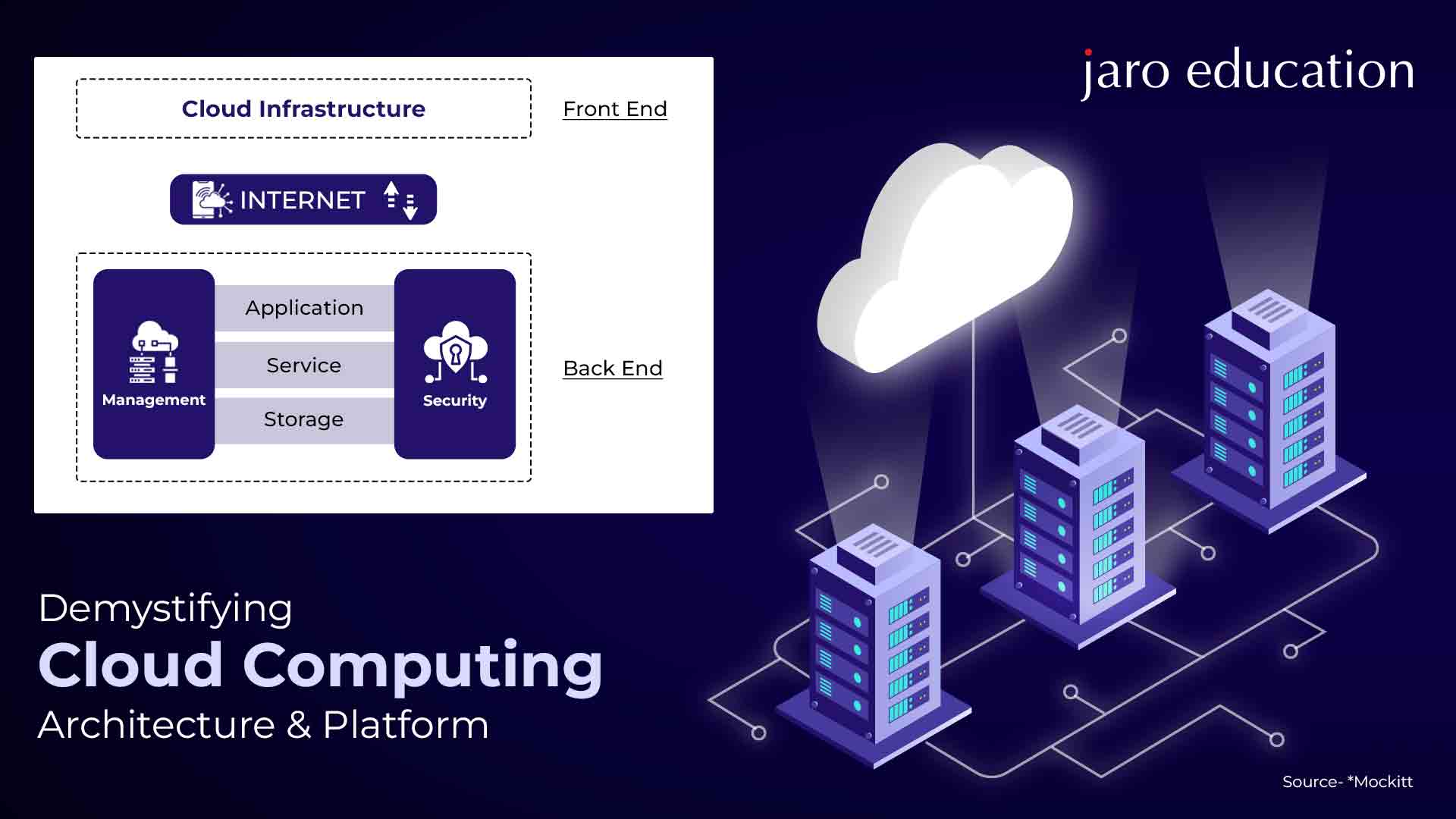Components of Cloud Computing Architecture

For developing cloud-based systems, the cloud computing architecture plays a foundational role. From design to integration of vital technologies and components, the necessity of cloud architecture cannot be ruled out. By defining the structure and connections between these elements, cloud architecture enables seamless operation and optimal utilisation of resources in the cloud environment.
When comparing the cloud with on-premises environments, it offers numerous benefits to businesses. From scalability and speed to expenses associated with the venture, people can benefit in manifolds by using the cloud. While a lift-and-shift strategy denoting moving existing applications with minimal alterations is commonly chosen by several organisations, ultimately, it becomes imperative to design and deploy applications as per the necessity of cloud environments. This approach ensures optimal utilisation of cloud capabilities and aligns applications with the unique demands and benefits cloud computing offers.
To keep yourself ahead in the world of cloud computing, joining IIT Palakkad’s PG Certification Programme in Cloud Computing can be a fruitful option. It provides a great opportunity for ambitious working professionals who want to advance their careers in this dynamic field. The course of 12 months offers a highly interdisciplinary curriculum designed by eminent IIT faculty with years of industry experience. From cloud foundations to microservices, the syllabus covers all aspects of cloud computing.
Components of Cloud Computing
Cloud computing architecture comprises several integral components that collaborate to deliver beneficial outcomes. Among the components of cloud computing are the frontend platform, the backend platform, the cloud-based delivery model, and the network.
Frontend Platform
It is the interface through which users interact with the cloud computing system. Frontend platforms include client-side applications, and user interfaces, along with client network or device that helps users access and interact with cloud computing services. For instance, you can access a Google Doc. on your mobile through a web browser and edit it at that moment. These three components are related to frontend cloud architecture.
Backend Platform
The backend platform is responsible for managing and processing the data and applications in the cloud. It consists of the servers, storage systems, and virtualisation technology that make up the cloud infrastructure. Furthermore, it ensures high availability, scalability, and security of the cloud resources. It also handles tasks such as data storage, processing, and network management.
Table of Contents
Components of the Backend Platform
Application
The backend software is the backbone the client interacts with from the front end. It handles and satisfies client requests and enables them to meet their needs.
Service
The service acts as the central core of cloud architecture, assuming responsibility for executing and managing a wide range of tasks within a cloud computing system. It governs the availability and allocation of accessible resources, like application development environments, storage, and web applications.
Storage
The storage element within the backend architecture comprises the data required to support application operations. Cloud storage solutions, which can vary across different providers, mainly offer highly scalable and adaptable storage services exclusively designed to handle extensive data volumes within the cloud environment. These storage options may include diverse technologies such as hard drives, persistent disks, or solid-state drives within server bays to ensure efficient data management.
Management
Effective management is crucial in cloud service models. It necessitates real-time resource management as per the user’s preference. Using management software or middleware facilitates seamless coordination between frontend and backend components. It helps allocate resources for the accomplishment of specific tasks. Besides middleware, this software has numerous functionalities like data integration, usage monitoring, disaster recovery, and application deployment.
Infrastructure
Cloud infrastructure encompasses essential hardware components such as CPUs, GPUs, network devices, and associated software, driving cloud services. In contrast, cloud architecture outlines the organisational blueprint for cloud resources and infrastructure.
Security
With the increasing adoption of cloud computing, prioritising robust security measures is a compulsion to safeguard data, platforms, and applications. Effective planning and design of data security, network security, and redundancy data loss prevention ensure visibility and downtime. Essential security practices may involve regular backups, debugging, and the implementation of virtual firewalls, to strengthen the overall security of cloud environments.
Internet
The internet connection serves vitally to mend the gap between the frontend and backend components of a system. It facilitates seamless communication and interaction between the front end and back end, enabling the flow of data and commands between the two.

Working Principle of Cloud Architecture
The integration of various components synergistically forms a cohesive cloud computing platform in cloud architecture. It enables users seamless and instant access to numerous services and resources.
The backend encompasses an extensive assortment of cloud computing resources, data storage, services, and applications provided by a cloud service provider. A network serves as the vital link connecting the frontend and backend components of the cloud architecture. This facilitates seamless data transmission between them. Whenever users engage with the front end, representing the client-side interface, their queries are relayed to the back end through middleware. Within the back end, the service model takes charge, executing the requested task or operation with precision.
The available service types differ according to the cloud-based service or delivery model the user chooses. Primarily, three cloud computing models are available, sufficing a varied range of services.
Infrastructure as a Service (IaaS)
Through this model, users can access various cloud infrastructures like storage, networking, and servers. This removes the need to manage, procure, and maintain on-premises services.
Platform as a Service (PaaS)
This model presents a computing platform that encompasses essential software tools and infrastructure, which equips users with an environment that helps to create, deploy, and oversee applications effortlessly.
Software as a Service (SaaS)
It is a model that presents cloud-based applications that service providers exclusively provide and maintain. This eliminates the requirement of local software deployment from the side of end users.
Layers of Cloud Architecture
Cloud computing architecture becomes easier to comprehend when all its components are segregated into layers stacked upon one another, forming a cloud platform. Below are the fundamental layers of cloud architecture you should know.
Hardware
The hardware, like storage, servers, and network devices, besides other hardware components, is the source of power for the cloud.
Virtualisation
It is an abstraction layer that curates a comprehensive virtual representation of storage resources and physical computing. This enables efficient resource utilisation and facilitates the sharing of resources among multiple applications.
Application and Service
This layer is an intermediary between the frontend user interface and the backend infrastructure. It supports user requests, providing various services based on the cloud service model employed. These services can include application development tools, resource allocation, and web-based applications.
Variations of Cloud Architecture
Cloud adoption is a highly individualised process, as it necessitates careful consideration of various factors. When implementing cloud, it is crucial to evaluate your existing technological investments, assess particular business requirements, and align with your objectives as a whole. This approach ensures that the chosen cloud type is well-suited to your unique needs and optimally supports your desired outcomes.
Public, Private, and Hybrid are the three major types of cloud architecture which will be discussed further.
Public Cloud Architecture
Public cloud architecture leverages cloud computing resources and physical infrastructure provided by a third-party cloud service provider. By utilising public clouds, you can effortlessly scale resources without needing personal hardware or software investments. However, it’s important to note that public clouds operate on multi-tenant architectures, serving multiple customers concurrently.
Private Cloud Architecture
Private cloud architecture offers an exclusive cloud environment owned and operated by an organisation. It is hosted privately within your own data centre, affording greater control over resources and increasing security for data and infrastructure. However, private cloud architecture can be more costly and demand higher IT expertise for maintenance and management.
Hybrid Cloud Architecture
Hybrid cloud architecture seamlessly integrates private and public cloud environments to provide versatile cloud services. By utilising a hybrid cloud, businesses can migrate workloads between environments. It ensures optimal utilisation of services that align with their specific business needs and workload requirements. This architecture is particularly advantageous for organisations seeking to retain data control while simultaneously capitalising on the benefits offered by public cloud offerings.
Multicloud Architecture
Another cloud architecture that is not considered among the primary types is multi-cloud architecture. It is emerging as a flexible option that helps match more use cases as it puts forward specific offerings, irrespective of vendor.
What are the Cloud Architecture Benefits?
Cost-effectiveness
By utilising the infrastructure of a cloud service provider, upfront costs for servers are eliminated. Dynamic provisioning helps optimise cost, as you pay only for the computing resources you use.
Faster time to market
Cloud architectures enable quick setup and configuration of computing infrastructure, reducing the time required to bring products to market. This allows for a greater focus on developing and delivering new offerings.
Scalability
Cloud architectures provide the flexibility to scale computing resources based on your specific infrastructure needs easily. Whether due to growth or seasonal spikes in traffic, you can quickly adjust resources to meet demand.
Accelerated transformation
Cloud-native architectures, like Kubernetes, accelerate modernisation efforts and drive digital transformation by leveraging cloud services and automated environments.
Increased innovation
Cloud architectures enable the utilisation of cutting-edge technologies, including storage, security, analytics, and AI, such as machine learning. This fosters innovation and empowers organisations to stay at the forefront of technological advancements.
High availability
Applications running on cloud architectures benefit from high-performance computing resources, ensuring continuous availability even during fluctuating workloads.
Robust security
Service providers of the cloud consistently enhance their security measures, employing expert professionals and the latest technologies to safeguard data, systems, and workloads. Regular upgrades and improvements are implemented to provide strong security mechanisms.
Services and Products Related to Cloud Architecture
The significance of cloud architecture cannot be overstated as you strategise your migration to the cloud. A well-designed framework is key to unlocking substantial business benefits, such as enhanced application performance, reduced operating costs, and improved end-user experiences.
Google Cloud offers comprehensive solutions to empower the construction of cloud architectures that align with an organisation’s present and future demands. This includes access to cutting-edge cloud technologies, a wide range of services, and design guidance and best practices that have been validated by seasoned industry experts.
Takeaway
The components of cloud computing architecture, including frontend and backend platforms, cloud-based delivery models, and network infrastructure, work together to provide scalable, flexible, and efficient cloud services. This architecture empowers organisations to leverage the benefits of cloud computing and drive innovation.
You can utilise cloud architecture to benefit your current setup optimally by enrolling for PG Certification Programme in Cloud Computing by IIT Palakkad. From active live sessions to extensive doubt-clearing sessions on various topics in cloud computing, this programme has got you covered. Register with Jaro Education to find out the details of this course, and look forward to a valuable professional course that can surely optimise your career growth.





